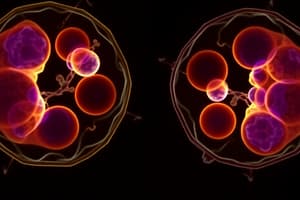Podcast
Questions and Answers
What does the M phase of the cell cycle primarily involve?
What does the M phase of the cell cycle primarily involve?
- DNA replication
- Mitosis and division of the cell (correct)
- Synthesis of RNA
- Cell growth
Which phase of the cell cycle is characterized by DNA synthesis?
Which phase of the cell cycle is characterized by DNA synthesis?
- G2 Phase
- G1 Phase
- S Phase (correct)
- M Phase
What is the maximum amount of time a human cell can spend in the G1 phase?
What is the maximum amount of time a human cell can spend in the G1 phase?
- 8 hours
- Half the cell cycle
- 11 hours (correct)
- 24 hours
How many pairs of chromosomes do humans possess?
How many pairs of chromosomes do humans possess?
What does the G1 checkpoint ensure before the cell proceeds to the S phase?
What does the G1 checkpoint ensure before the cell proceeds to the S phase?
Which term refers to the resting stage in the cell cycle where a cell is not actively preparing for division?
Which term refers to the resting stage in the cell cycle where a cell is not actively preparing for division?
During which phase does a cell replicate its DNA and form sister chromatids?
During which phase does a cell replicate its DNA and form sister chromatids?
What is produced during the G2 phase of the cell cycle?
What is produced during the G2 phase of the cell cycle?
What happens during the G2 checkpoint if DNA damage is detected?
What happens during the G2 checkpoint if DNA damage is detected?
Which of the following best describes the duration of mitosis compared to the G2 phase?
Which of the following best describes the duration of mitosis compared to the G2 phase?
What characterizes prophase in the mitosis phase?
What characterizes prophase in the mitosis phase?
What is a possible outcome of endoreplication in cells?
What is a possible outcome of endoreplication in cells?
Which of the following phases occurs immediately after metaphase in mitosis?
Which of the following phases occurs immediately after metaphase in mitosis?
What condition is characterized by an extra chromosome present in an individual's cells?
What condition is characterized by an extra chromosome present in an individual's cells?
What is the role of the cleavage furrow during cytokinesis in human cells?
What is the role of the cleavage furrow during cytokinesis in human cells?
Flashcards are hidden until you start studying
Study Notes
The Cell Cycle
- Four main phases: G1, S, G2, and M (mitosis).
- G1: Cell growth, checks environmental conditions, and prepares for replication. A committed step (restriction point in mammals, start in yeasts) leads to the S phase. Can last up to 11 hours.
- S: DNA synthesis and duplication, creating sister chromatids joined by centromeres. Approximately 8 hours in human cells.
- G2: Production of intracellular materials and organelles for daughter cells. Includes a checkpoint for DNA damage; repair or apoptosis may occur. Lasts roughly 4 hours.
- G0: A resting phase where the cell is neither growing nor preparing for division.
- G1, S, and G2 phases together constitute interphase (approximately 90% of the cell cycle).
Mitosis (M Phase)
- Lasts roughly one hour.
- Produces two identical diploid daughter cells from a single parent cell.
- Five phases: prophase, prometaphase, metaphase, anaphase, and telophase/cytokinesis.
Mitosis Phases
- Prophase: Chromosomes condense, mitotic spindles form, centrosomes move to opposite cell ends.
- Prometaphase: Nuclear membrane breaks down, microtubules attach to kinetochores on chromosomes.
- Metaphase: Chromosomes align at the metaphase plate (cell center).
- Anaphase: Sister chromatids separate and move to opposite cell poles.
- Telophase: Two daughter nuclei form, nuclear envelopes reassemble. Cytokinesis (cytoplasm division) follows. In human cells, this involves a cleavage furrow.
Errors in Mitosis
- Aneuploidy: Incorrect chromosome number in a cell, often caused by nondisjunction (chromosome failure to separate). ~5% of trisomy cases are due to mitotic errors.
- Trisomy: An extra chromosome (e.g., Down syndrome – Trisomy 21).
- Endoreplication: Multiple genome copies created during S phase; a response to environmental stress. Rare in mammals, but can be beneficial in plants.
Cell Cycle in Humans
- A single human cell takes up to 24 hours to complete one full cell cycle.
- Humans have 23 pairs of chromosomes (diploid).
Studying That Suits You
Use AI to generate personalized quizzes and flashcards to suit your learning preferences.



